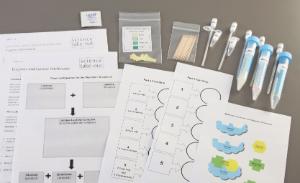Key Concepts of Enzymes; Plus a free handout from AccessScience
Access to this content is available to Ward’s World readers for free from McGraw Hill’s AccessScience, an award-winning, digital STEM resource that provides immediate, authoritative answers to students’ thirst for scientific knowledge on topics such as climate change, virology, pollution, and more. Ward’s World and McGraw Hill have partnered to offer educators a no-obligation, free trial subscription to this product. Request your free trial today and discover how valuable AccessScience can be for you and your students.
High School
Cells are considered the smallest form of life that can divide, multiply, grow, and respond to environmental stimuli. These microscopic building blocks of life produce the proteins, chemicals, and signals behind everything that happens in our bodies. And enzymes play an essential role in cell function. Without enzymes, all those life-sustaining reactions would happen too slowly for cells to survive. So, whenever a cell needs to get stuff done, it usually relies on enzymes to speed things along.
Technically speaking, an enzyme is a biological catalyst and is almost always a protein (but could be an RNA). It speeds up the rate of a specific chemical reaction in the cell. The enzyme is not destroyed or altered during the reaction and is used repeatedly. A cell contains thousands of different types of enzyme molecules, each specific to a particular chemical reaction.1
Studying enzymes in cells falls under the organic chemistry science branch. Students who are interested in pursuing careers as doctors, veterinarians, dentists, pharmacologists, chemical engineers, or chemists will find organic chemistry part of their college coursework. Your lesson plans on enzymes can help catalyze their success in organic chemistry.
What are some practical applications of enzymes?
Enzymes are highly efficient and selective biocatalysts. Their unique characteristics make them highly applicable for many chemical transformation reactions in
Medicine. Enzymes have applications for disease diagnosis and treatment, and drug manufacturing. Specialized enzymes (e.g., cholinesterase, decarboxylases dehydrases), are used in therapies for treating many diseases, such as leukemia, skin ulcers, cardiovascular diseases, Parkinson’s disease, inflammation, digestive disorders, pancreatic disorders, etc. Enzymes used as drugs have two important characteristics that are different from traditional drugs. First, enzymes bind and act on their targets with great affinity (attraction). Secondly, enzymes are highly specific and act as catalysts to convert multiple target molecules to the desired products. These two features make enzymes specific and potent drugs that can accomplish therapeutic biochemistry in the body that small molecules can’t.2
Nature. Enzymes are vital to all forms of life, such as microorganisms, plants, and animals. Plant photosynthesis would not be possible without enzymes. The enzyme ribulose-1,5-bisphosphate carboxylase/oxygenase (aka RuBisCo) incorporates CO2 into plants during photosynthesis. RuBisCo makes up about 30% of the total protein in a plant leaf, making it the most abundant protein on earth.3
Ruminants (hoofed herbivorous mammals) use the cellulase (enzymes) produced by the microbes in their stomach to break down the plant cellulose into nutrients they can absorb. Since the cow, like other mammals, has no cellulose-digesting enzymes of its own, it relies on the digestive activity of the helpful microbes in its gut. This is the only way cows can get nutritional value to make all that cud-chewing worthwhile, and that’s no bull!
Food. The food industry uses enzymes as processing aids to produce many everyday products, such as:
- Dairy products: cheese, milk, yogurt
- Bakery products: bread, cookies
- Meat
- Drinks: fruit juice, beer, wine
Fermented foods are foods or beverages produced through controlled microbial growth and the conversion of food components through enzymatic action.
Technology. Researchers and manufacturers use technical enzymes in detergents, textiles, pulp and paper, cosmetics, organic synthesis, and biofuels. For example, when you press eco-mode on your washing machine, you can thank enzymes for the clean clothes. This is because the detergent’s enzymes are optimized to work at lower temperatures, saving energy throughout the cold wash cycle.
Download McGraw Hill’s AccessScience article, Enzymes, for an in-depth examination of these amazing tiny molecular machines that make life possible. The free download also includes assessment questions and answers you can use to test student understanding.
1. National Human Genome Research Institute: Enzymes. 2. Creative Enzymes. Enzymes in Pharmaceutical Industry. 3. The Proceedings of the National Academy of Sciences (PNAS): Activation of Rubisco regulates photosynthesis at high temperature and CO2.
Recommended Products
[StartProductBlock]

Ward's® AP Biology Investigation 9: Genetics and Information Transfer: Restriction Enzymes
Use electrophoresis technology to analyze DNA sequence by fragment analysis.
[EndProductBlock]
[StartProductBlock]

Science Take-Out® Enzymes and Lactose Intolerance
How does the dietary supplement ACTAID work to help people with lactose intolerance? Model the action of the enzyme lactase.
[EndProductBlock]
[StartProductBlock]

Enzyme Catalysis Lab Activity
Measure the activity of the enzyme catalase, converting hydrogen peroxide to water and oxygen gas.
[EndProductBlock]
